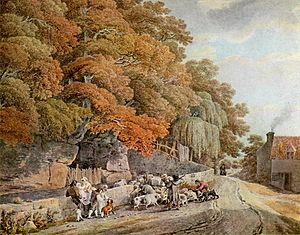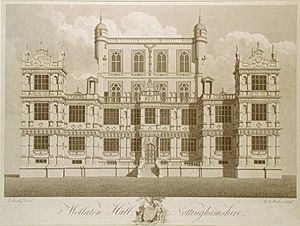Michael Angelo Rooker facts for kids
Michael Angelo Rooker (1746 or 1743 – 3 March 1801) was an English artist. He was known for painting landscapes and buildings using oil and watercolour. He also worked as an illustrator and an engraver, which means he made pictures by carving them into metal plates. Michael Rooker was also the main scene painter at the Haymarket Theatre in London.
Contents
Early Life and Artistic Training
Michael Rooker was the son of another artist, Edward Rooker. His father taught him how to engrave. He also learned drawing from a famous artist named Paul Sandby. Michael studied at the St. Martin's Lane school in London and later at the Royal Academy Schools. It was Paul Sandby who jokingly called him Michael "Angelo" Rooker, and the name stuck!
Artistic Career and Achievements
In 1765, Michael Rooker showed some of his drawings in an exhibition in London. A few years later, in 1768, one of his engravings of the 'Villa Adriana' was published. In 1770, he became an Associate of the Royal Academy. This was an important step for an artist, showing he was recognized by a leading art institution.
In 1772, he displayed a painting of Temple Bar, a famous London landmark. He also created illustrations for a book by the writer Sterne that same year. Michael Rooker engraved most of the landscapes for Kearsley's Copperplate Magazine (1776–1777). He also drew and engraved the pictures for the Oxford Almanack for several years, earning £50 for each one.
Work at the Theatre
For many years, Michael Rooker was the main scene painter at the Haymarket Theatre in London. He was even called Signer Rookerini in the theatre programs! However, a few years before he passed away, he left his job at the theatre after some disagreements.
Later Work and Legacy
Starting in 1788, Michael Rooker began taking trips around the country in the autumn. During these trips, he created many drawings that helped him become known as one of the first important watercolour artists. His drawings often showed old buildings and ruins in places like Norfolk, Suffolk, and Somerset. He was very good at drawing these structures and added people and animals to his scenes in a very artistic way.
Michael Rooker felt sad after leaving the Haymarket Theatre. He passed away suddenly in his chair in Dean Street, Soho, on 3 March 1801. His drawings were later sold at an auction, bringing in a good amount of money, about £1,240.
Michael Rooker never married and lived his whole life in London. He showed one drawing at the Society of Artists and ninety-eight drawings at the Royal Academy. A very famous artist named J. M. W. Turner admired Rooker's work. Turner even learned a painting technique by copying Rooker's "Gatehouse at Battle Abbey." After Rooker's death, Turner bought more than a dozen of his paintings.
Images for kids





